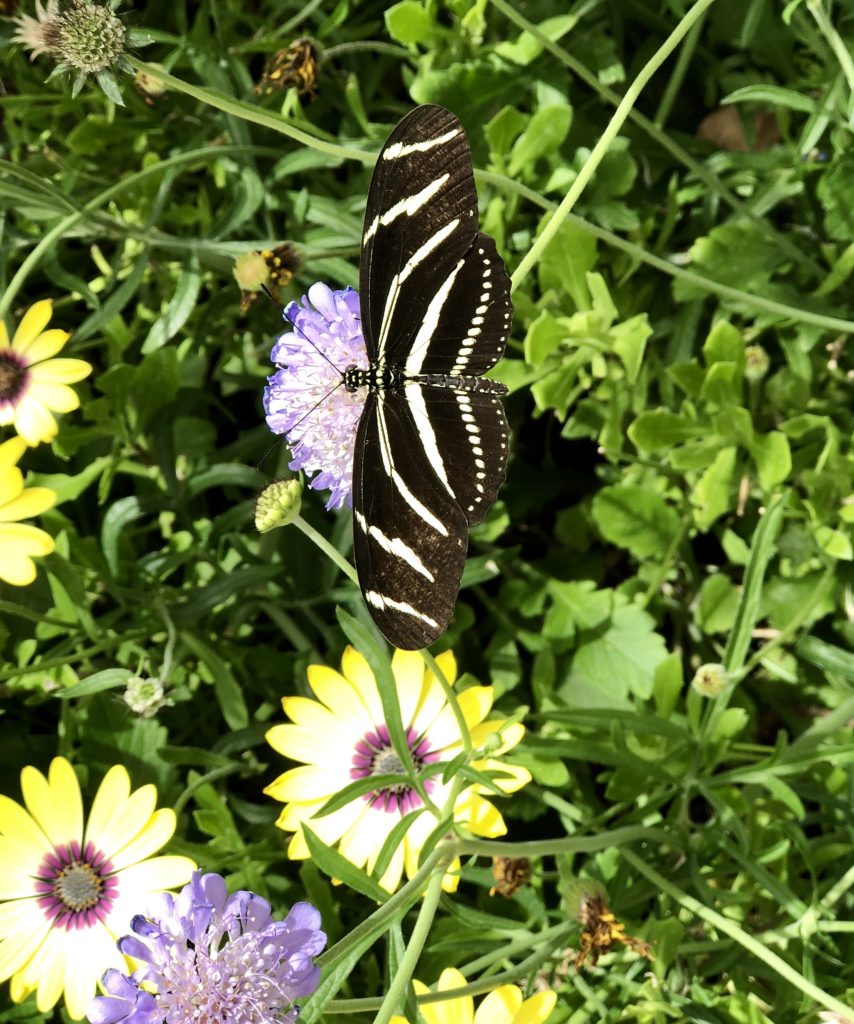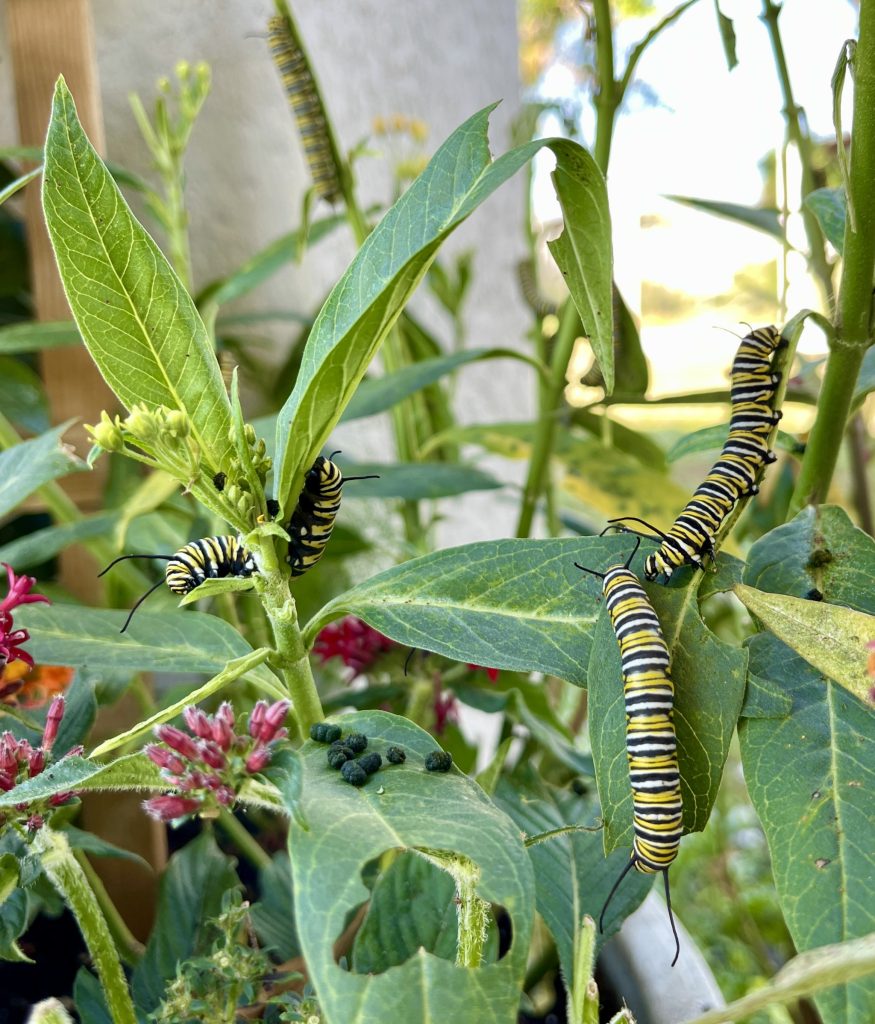This complete guide to creating a butterfly garden in Florida has all of the information you need from the best Florida native host plants to native plants to attract butterflies. As someone who loves butterflies and gardening, I’m excited to share my tips on creating a beautiful butterfly garden right in your own backyard. With a little bit of planning and effort, you can attract a variety of butterfly species to your garden and enjoy their beauty up close. Let’s get started!
I live in Southwest Florida and I love that here, you can enjoy your butterfly garden year around! Before you start planting, it’s important to understand what butterflies need to thrive. Butterflies need two things: food and shelter. Food comes in the form of nectar from flowers, while shelter comes from plants that serve as host plants for butterfly eggs and larvae.
It’s also important to understand what USDA Plant Hardiness Zones you are in. For example in Fort Myers and Cape Coral, where I live there we are in 10A, 10B and 11 Plant Hardiness Zones.

The first step in creating a butterfly garden is to choose a sunny location. Butterflies are cold-blooded insects, and they need the sun’s warmth to regulate their body temperature. Choose a spot that gets at least six hours of sun per day.
Once you’ve chosen your location, it’s time to prepare the soil. Remove any weeds or grass and loosen the soil with a garden fork or tiller. You can also add compost or other organic matter to improve soil quality and drainage.

What Plants are Ideal to Attract Butterflies in Florida
Now that you’ve prepared the soil, it’s time to start planting! Here are some of the best plants to attract butterflies in Florida:
- Milkweed – This plant is a must-have in any butterfly garden, as it is the only host plant for monarch butterflies. Milkweed also attracts other butterfly species with its fragrant flowers.
- Zinnias – These colorful flowers provide a great source of nectar for butterflies, and they bloom from late spring to early fall.
- Lantana – This plant has bright, colorful flowers that are attractive to both butterflies and hummingbirds. Lantana is also a great choice for hot, dry areas.
- Pentas – These flowers are available in a variety of colors, and they bloom from spring through fall. They are also known for attracting swallowtail butterflies.
- Salvia – This plant has spikes of purple or blue flowers that bloom in the summer and fall. It attracts many species of butterflies, including monarchs.

Best Host Plants for Butterflies in Florida
In addition to nectar-rich flowers, it’s important to include host plants in your butterfly garden. Host plants are specific plants that butterflies lay their eggs on, and they serve as food for butterfly larvae. Here are some of the best host plants for butterflies in Florida:
- Milkweed – As mentioned earlier, milkweed is the only host plant for monarch butterflies.
- Passionflower – This vine is a host plant for Gulf fritillary butterflies. It also has unique and beautiful flowers.
- Cassia – This plant is a host for sulphur butterflies. It has yellow flowers that bloom in the summer and fall.
- Dill – This herb is a host plant for black swallowtail butterflies. It also attracts other beneficial insects like ladybugs and lacewings.
- Fennel – This herb is a host plant for black swallowtail butterflies. It has feathery foliage and yellow flowers that bloom in the summer.
- Citrus trees – The Black Swallowtail butterfly uses citrus trees, such as lemon and lime trees, as host plants.
- Pipevine – The Pipevine Swallowtail butterfly lays its eggs on pipevine plants. These plants are native to Florida and can be a bit difficult to find, but they are well worth the effort if you want to attract this beautiful butterfly to your garden.

Why Choose Native Plants for Your Butterfly Garden
When creating a butterfly garden, it’s essential to choose plants that are native to the area you live in. Native plants are the best option for your butterfly garden as they provide food and shelter for local butterfly species, which have evolved to rely on them for survival. Non-native plants may not be able to provide the same level of nutrition and protection, which can impact the butterfly’s life cycle and overall population.
Choosing native plants also helps to maintain the balance of the local ecosystem. Native plants have adapted to the climate and soil conditions of the area, making them more resilient to local pests and diseases. This means that they are less likely to require harmful pesticides or fertilizers, which can harm not only the butterflies but also other important pollinators like bees and birds. Additionally, native plants can help prevent soil erosion and filter pollutants, contributing to the overall health of the environment.
Butterfly Host Plants that are Native to Florida
There are several species of milkweed, passionflower, and pipevine that are native to Florida. Here are some of them:
-
Florida Native Milkweeds:
- Asclepias tuberosa (Butterfly Weed)
- Asclepias incarnata (Swamp Milkweed)
- Asclepias verticillata (Whorled Milkweed)
- Asclepias humistrata (Pinewoods Milkweed)
- Asclepias perennis (Aquatic Milkweed)

-
Florida Native Passionflowers:
- Passiflora suberosa (Corky-stemmed Passionflower)
-
Florida Native Pipevines:
- Aristolochia serpentaria (Virginia Snakeroot)
It’s important to note that not all milkweed, passionflower, and pipevine varieties are suitable for all regions of Florida. It’s important to choose varieties that are native to your specific region for the best results in your butterfly garden.
How Adding a Trellis Arbor with Butterfly Host Plant Vines Gives Your Butterfly Garden a Great Focal Point
One way to create a focal point in your butterfly garden is to add a trellis arch covered in butterfly host plant vines. This not only adds visual interest to your garden, but it also provides a sheltered area for butterflies to lay their eggs and for larvae to feed.
Some great plants to use on a trellis arch include passionflower, coral honeysuckle, and butterfly pea vine. These plants have attractive foliage and flowers, and they also serve as host plants for a variety of butterfly species.

Here are some tips for adding a trellis arch to your butterfly garden:
- Choose a sturdy, weather-resistant trellis arch that can support the weight of the plants you want to grow. I love the Yaheetech 85in Wood Backdrop Stand Arbor. You can Yaheetech 85in Wood Backdrop Stand Arbor.
- Position the trellis arch in a sunny spot where it will receive at least six hours of direct sunlight per day.
- Plant the host plants at the base of the trellis and train the vines to climb up the trellis using garden twine or plant ties.
- Prune the vines regularly to keep them from becoming too tangled and to promote healthy growth.
- As the vines grow, they will form a beautiful canopy over the trellis arch, providing shade and shelter for butterflies and other pollinators.
About Yaheetech Products
Yaheetech is a cross-border e-commerce company established in 2003 with more than 500 employees worldwide. With their own 39 warehouses around the world, they provide a wide range of products with fast delivery to millions of customers in more than 10 countries, available on Amazon, Walmart, eBay, Wayfair, Wish, Cdiscount, ManoMano, OTTO, Rakuten, Real and more. The company is devoted to making your life comfortable.

- Guatemalan Dulce de Chilacayote Recipe (Crystalized Chilacayote Candy) - February 26, 2024
- Guatemalan Naranjas en Miel Recipe (Candied Oranges Recipe) - February 25, 2024
- Traditional Guatemalan Candy - February 25, 2024



